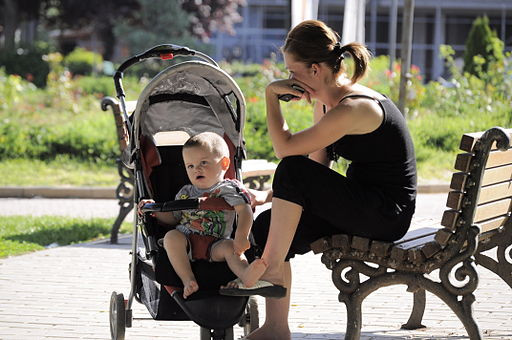
fciwomenswrestling.com article - Wikimedia photo
The new stay at home mom’s numbers are steadily increasing. Are you one of them?
This is a conversation that has most likely happened more than once in a typical family between two young adults expecting to get married and their parents.
The discussion centers around how the future child rearing will be paid for or accomplished once the children are here.
In our circle, someone’s son is soon to be married and these are questions that have been asked and discussed around the fireplace, in the mall or at the park.
The questions usually follow rapid fire. Will mom stay at home until the children are a certain age? If the parents are college educated, will both pursue a career or will one do so while the other works part time? Are they expecting the grand parents to help out and if so, how much of the time?
Let’s first examine the costs of daycare which can vary greatly depending upon what city or state you live in.
The respected site babycenter.com shares, “While your child is in the baby and toddler stages, you’ll pay more. That’s because kids this age need more hands-on care and so the center must hire more caregivers.
The average cost of center-based daycare in the United States is $11,666 per year ($972 a month), but prices range $3,582 to $18,773 a year ($300 to $1,564 monthly), according to the National Association of Child Care Resource and Referral Agencies. Parents report higher costs – up to $2,000 a month for infant care – in cities like Boston and San Francisco.
Topping the charts with costs over $10,000 a year for baby and toddler daycare are the following states, beginning with the most expensive: Massachusetts, New York, Minnesota, Colorado, California, Illinois, Washington, and Wisconsin.
By contrast, the states with least expensive childcare are Mississippi ($4,650 a year on average for an infant or toddler), Kentucky ($6,500), and South Carolina ($5,850).”
The site explains further; “Costs for daycare for preschool-age children are generally lower, averaging $8,800 a year ($733 a month). Depending on where you live, you’ll pay anywhere from $4,460 to $13,185 a year ($371 to $1,100 a month).
The most expensive states for preschool-age care in a childcare center, with costs over $8,000 a year ($667 a month), beginning with the most expensive, are Massachusetts, New York, Minnesota, Wisconsin, Rhode Island, Colorado, and Pennsylvania…
The least expensive states for preschool-age care in a childcare center, with costs ranging from less than $4,000 a year ($333 a month) to around $7,000 a year are Mississippi, Kentucky, Louisiana, Kansas, Missouri, Oklahoma, Idaho, West Virginia, South Carolina, and Alabama.”
As the costs of daycare go up, it is influencing change. Due to these costs there is a new stay at home model that is clearly different from the models of times past though the name remains the same.
There are days when I struggle with wanting to be a full-time, stay-at-home mom, and feeling guilty about that because I work.………Tori Spelling
According to the widely respected pewresearch.org, “A greater share of mothers are not working outside the home than at any time in the past two decades.
After declining for several decades — bottoming out at 23% around the turn of the century — the share of stay-at-home mothers has risen in fits and starts over the past decade and a half, to 29% in 2012, according to the Pew Research analysis of census data.
While there are many reasons driving this trend, one likely reason is the rising cost of child care. A 2010 Census paper (which focused on married stay-at-home mothers) commented that “especially for mothers who have more than one child under 5, the cost of day care might be higher than she could support unless she has fairly high earnings.”
Mothers who do work are paying more than ever for child care.
There are many women with children under five who want to work and who lack affordable, high-quality child care.………Harriet Harman
In inflation-adjusted dollars, average weekly child care expenses for families with working mothers who paid for child care (24% of all such families) rose more than 70% from 1985 ($87) to 2011 ($148), according to research by the Census Bureau. For those families, child-care expenses represent 7.2% of family income, compared to 6.3% in 1986 (the earliest year available).
But child care costs hit families at different income levels very differently, according to the census data. In 2011, for instance, families with employed mothers whose monthly income was $4,500 or more paid an average of $163 a week for child care, representing 6.7% of their family income. Families with monthly incomes of less than $1,500 paid much less –$97 a week on average — but that represented 39.6% of their family income.”
Female Competition International (fciwomenswrestling.com) speaks to a large female audience who either has small children or are thinking about starting a family at some point in the near future. We strongly suggest that you sit down with the family members who may be affected by your decision, discuss and consider as many options as possible but above all please consider the cost.
So much of the decision making depends upon a person’s current financial situation. The above cited study continues.
“One of the most striking demographic differences between stay-at-home mothers and working mothers relates to their economic well-being. Fully a third (34%) of stay-at-home mothers are living in poverty, compared with 12% of working mothers.
There also is substantial variation among stay-at-home mothers. Those who are married with working husbands generally are better off financially than the other groups. They are more highly educated, and relatively few are in poverty (15%), compared with a majority of other stay-at-home mothers. Married stay-at-home mothers (whether their husbands work or not) also are markedly more likely than single or cohabiting stay-at-home mothers to be foreign born. Single or cohabiting stay-at-home mothers are younger than their married counterparts; most are younger than 35, compared with about four-in-ten married stay-at-home mothers.”
Having a family and successfully raising children is a wonderful and powerful worthwhile life experience. The chances of having a great experience increases the more you communicate to your loved ones and develop a plan.
~ ~ ~
Femcompetitor.com subscribes to fciwomenswrestling.com news source. No affiliation.
Sources: brainyquote.com, babycenter.com, pewresearch.org, fciwomenswrestling.com, photos thanks to Wikimedia commons.



